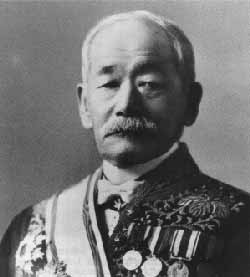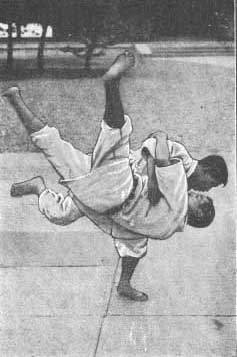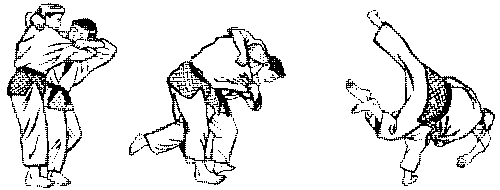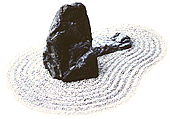JujitsuThe exercise which is now practiced throughout the world under the simple name of Judo should, properly speaking, be called the Kodokan Judo. We will, therefore, give an outline of the history of the Kodokan Judo in the following chapters. The Kodokan Judo of today is based on the traditional jujitsu or jujutsu of old japan. The techniques of the latter, re-examined, refined, systematized, and welded to an ideal, became those of the former. Thus, it may be said that the Kodokan Judo has elevated jutsu, “art” or “practice”, to do, “way”, or “principle”. What then was jujitsu, the prototype of Judo? It has been known by a dozen different names–such as ‘yawara’, ‘taijutsu’, ‘wajutsu’, ‘torite’, ‘kogusoku’, ‘kempo’, ‘hakuda’, ‘kumiuchi’, ‘shubaku’, ‘koshinomawari’, etc. It had numerous schools each of which was distinguished from the others by its own individual features. But generally speaking, jujitsu may be defined as an art of attack and defence without or occasionally with weapons against an opponent, with or without weapons. The origin of jujitsu is lost in the mists of antiquity. The ‘Nihon Shoki’, “The Chronicle of Japan”, a history, compiled by Imperial command in 720 AD, refers to a tournament of ‘Chikara- Kurabe’, the contest of strength, which was held in the 7th year of the Emperor Suinin, 230 BC. This is regarded by some historians as the beginning of Sumo, or japanese wrestling, which has something in common with jujitsu. Although it is questionable, whether the said Chikara-Kurabe bore any relation either the Sumo or Jujitsu of later days, the event is recorded as an important authentic historical proof showing the embryonic stage of both sumo and jujitsu in the remote past. According to Draeger and Smith (page 133), the claim that the Takenouchi Ryu was the core jujutsu ryu from which all jujutsu sprang has been shown to be less than accurate. However, the combat techniques from this ryu can be considered a turning point from which various systems came to be identified. This ryu was founded in 1532 and borrowed substantially from sumo. Takenouchi devised combat method from various sources that came to be known as ‘kogusoku’. This method and others were later classified under the common heading of jujutsu. The first instance of the word ‘yawara’ occurring in japanese literature is to be found in the ‘Konjaku-Monogatari’, the Once- upon-a-time Stories, which are said to have been written in the latter half of the 11th century. As the word ‘Yawara’ mentioned in that book is found in a story about Sumo, we cannot identify in directly with Jujitsu, but in any case, it is an interesting documentary item which deserves the attention of jujitsu historians. According to the Bujutsu-Ryusoroku, the Biographies of the Founders of Various Martial Exercise Schools, and other kindred materials, there existed in the days prior to the establishment of the Kodokan Judo some twenty ‘Ryu’, schools, of jujitsu, such as the ‘Takenouchi Ryu’, ‘Sekiguchi Ryu’, ‘Kyushin Ryu’, ‘Kito Ryu‘, and ‘Tenshin-Shinyo Ryu‘, the last two of which were especially studied by the late Professor Jigoro Kano–our founder. The differences between these various schools were chiefly attributable to specialization in certain techniques of jujitsu by the teachers. But at times it would seem that a few Jujitsu masters founded new schools simply for their own publicity purposes, for there were schools differing in name but practically identical in substance. (Draeger and Smith, page 134, note that there were 725 officially documented jujutsu systems that developed in Japan.) The Circumstances Which Led to the Rise and Development of Jujitsu(a) Before the advent of firearms in Japan, bows and arrows had been employed in warfare from the earliest times. In close combat, swords and spears were used by the warriors, and occasionally they had to fight with their bare hands. This was called ‘Kumiuchi’, the more advanced techniques of which contributed to the development of jujitsu. (b) For centuries the Japanese warrior used to wear two swords, one long one short, until this custom was banned in 1871, under the Decree Abolishing the Wearing of Swords. However, often when in the presence of high personages he had to appear without the long sword. Especially in the Tokugawa period, the long swords were taboo in the court of the Shogun, while the retinue on guard, and the minor officials were allowed to wear the short swords only. The same was the case with the prison keepers. They needed a special art for self-defence, as well as for controlling their charges without killing them. (c) Special methods such as hitting, poking or chopping with the hand, fingers, elbow and fist, kicking with the knee-cap, heel or ball of the foot, or bending and twisting the joints, were studied and developed so that an unarmed person or a person who was purposely restrained from using his weapons could subdue an adversary. (d) For several hundred years before the Meiji era, throughout the feudal age, class distinction was rigidly enforced between the warrior and the commoner, the latter being ordinarily forbidden to wear any sword. Naturally for self-defence purposes commoners had to learn the art of bare-handed fighting. The basic circumstances described above that led to the development of jujitsu are closely interlocked and cannot be clearly separated one from another. But, from the extent ‘Densho’ the manuscriptal instruction and records of secrets by the founders of various schools, we may readily perceive their respective characteristics. For instance, in some ‘Densho’, there are minute instructions, together with pictorial illustrations, on how to capture a ruffian and bind him with rope. Such details, though they may lie outside the scope of jujitsu proper, are profoundly interesting where they serve to show concretely the kind of soil out of which a particular jujitsu technique has grown. For a historical study of jujitsu there are two sources: (1) historical and literary works in general, and (2) the various ‘Densho’ mentioned before. History books contain comparatively few references to jujitsu, but there are more to be found in the miscellaneous writings of each period. As for the documents of individual schools, each school in its eagerness to add lustre to itself and to enhance its own prestige adorned its origin and records with flowery rhetoric, so that their contents in some cases will have to be taken with a grain of salt. Moreover, some ‘Densho’, while of antique origin, are manuscript copies of later hands, so that a high degree of authenticity is doubtful. Nevertheless, it may be safely deduced from the records available today that jujitsu began to take a systematized form in the latter half of the 16th century and that the various schools came into being in the centuries from the 17th to about the beginning of the 19th. As for the tenets, or doctrinal principles, of jujitsu, the instructions of the various schools mostly dwell on the ideas which may be seen in the famous old book on strategy selected by the Chinese strategist, Hwang-Shihkon, which was the Bible of our warriors in the feudal age, namely “In yielding is strength” (“Oaks may fall when reeds brave the storm”). The also carry echoes of the Chinese Philosophy represented in the Book of Lao-tsze, who preached non-resistance and gentleness, etc., or the Yi-King (or I Ching), the Book of Changes. There is little original thinking, although occasionally one encounters passages which indicate an aspiration to the ideal of ‘Bushido’, the passages which are exactly in line with the spirit of Kodokan Judo. Draeger and Smith (page 137) add the following note: “‘Ju’ is a chinese character meaning ‘pliable’, ‘submissive’, ‘harmonious’, ‘adaptable’, or ‘yielding’. The common translation of ‘ju’ as ‘gentle’ is usually misinterpreted by the westerner. To him it suggests the complete lack of functionally applied strength. This was never the case with combat ‘jujutsu’. where frequently great strength was needed to insure the defeat of an enemy. ‘Jujutsu’ techniques are not all gentle, though sometimes they are made with such swiftness and efficiency that they appear to be so. They seek to blend with the enemy’s direction of strength, which is then controlled. This ‘gentleness’ is thus more correctly spoken of as ‘flexibility’, meaning that mind and body adapt to a situation and bring it to advantage for the operator. Furthermore, the principle of ‘ju’ is not as all- pervading as exponents of systems who have taken it at its face value would have to all to believe. “The willow does not break under the load of snow,” reads an old Oriental maxim. From this, some systems extend this limited philosophy to cover the absolute range of mechanical actions for their systems. While some snow may not “break the willow,” a correctly applied force will. An enemy who attacks with such forces cannot be turned aside by ‘ju’.” A word may be added about the legend that jujitsu was originally introduced to japan by a chinese named Chen Yuan-ping, approximately in 1644-48, or in 1627 according to the ‘Kokushoji’ document. However, a large amount of authentic evidence disproves this. For instance, we have reliable records of the japanese jujitsu masters, such as Hitotsubashi-Joken, or Sekigushi-Jushin, who thrived years before the above dates. Authentic descriptions of jujitsu are found in documents such as ‘Yukisenjo-`Monogatari’, ‘Kuyamigusa’, and the old jujitsu ‘Densho’, which also predate the legend. This is not necessarily to deny that Chen Yuan-Ping introduced chinese boxing, ‘kempo’, to japan. Indeed, it is more or less reasonable to assume that ‘kempo’ has some influence on jujitsu. The Development of Kodokan Judo Those were the years during which japan witnessed many revolutionary changes, political and otherwise. The Tokugawa Shogunate crumbled, and the Imperial rule was restored in 1868. With the collapse of the feudal system the nation, casting to the wind all culture and institutions of old, was avidly aping the ways of the advanced countries of Europe and America. For example, the Noh drama, one of the traditional arts of country, was suddenly deprived of the patronage of the clan lords, who incidently lost their princely domains. A story is told of a famous Noh master, who went begging from door to door reciting popular passages from his repertoire. The ordinance prohibiting samurai from wearing swords, 1871, signalled a swift decline of all martial arts, and jujitsu was no exception. Its various schools, once strongly entrenched at numerous clan capitals throughout the country, were now tottering on the brink of ruin. Just how did Jigoro Kano, a student of Tokyo Imperial University at the age of eighteen, happen to take up this dying art? The question is simply answered. A young gentleman of no sizable physique he was too proud to yield, and smarting under the bullying of bigger companions, he wanted to get strong by some means or other. On hearing about jujitsu, an exercise by which a man of small strength can beat a man of herculean strength, he at once made up his mind to learn it. However, owing to the social conditions, as mentioned above, which had caused many jujitsu masters to turn to other occupations, it was difficult to find a suitable teacher. He finally met Teinosuke Yagi, who taught him the rudiments of jujitsu. Later he studied under Hachinosuke Fukuda (note: the grandfather of Keiko Fukuda, 8th dan, who is the highest woman judoka alive) and Masatomo Iso of the Tenshin Shinyo Ryu, and Tsunetoshi Iikubo of the Kito Ryu, and was initiated into the secrets of both schools. Then he established his own school, named Kodokan, in 1882 and began to teach his own exercise calling it Judo instead of jujitsu. He was then twenty three years old and one of the faculty of the Gakushuin, the Peers’ school. Meanwhile his characteristic zeal and tireless energy was not satisfied with this, he continued to explore the mysteries of other schools as well as to improve his own exercise, taking great pains to visit other famous masters of the art and to study the old ‘Densho’. Finally he attained a height hitherto unknown in the realm of jujitsu. Note – Kano’s approach to the development of Judo and the study of Jujitsu is illustrated in the following extract from Watanabe and Avakian, “The Secrets of Judo” (1960, p35-36) regarding the discovery of kuzushi or the principle of unbalancing the opponent, Professor Kano reporting his discovery said:
The process of the evolution of Judo from Jujitsu is told by Professor Kano in one of his early lectures given to his students in 1898.
Such was the outline of the genesis of the Kodokan Judo as told in the words of Professor Kano himself.
When the Kodokan was first established in 1882, its Dojo the exercise hall, was only a 12 mat, 12’x18′, in size, and the students in the first year numbered nine in all. Today the Kodokan which recently celebrated the 70th anniversary (note: as of 1964 publication date) of its founding has a 500-mat, 100’x100′ exercise hall and the number of pupils, men, and women, young and old, and disregarding race and nationality is counted in millions. One of the ardent visions during the last days of the late Professor Kano, the International Federation of Judo, is realized at last, with his son, the present president of the Kodokan, as the president of the Federation and with the Kodokan as its headquarters. When we look back upon the past, our hearts are full of deep emotion. Many stories and anecdotes are told of the difficulties which confronted Professor Kano and the great pains taken by him when teaching the art of Judo in the early days of the Kodokan, but we regret that we are compelled to omit them because of the lack of space. Having endured every hardship and having overcome many difficulties, the Kodokan in spite of its youth and small size made rapid progress, winning wide public recognition in a few years. Then in 1886, it gained in a dramatic fashion undisputed leadership in the field. About that time, with the stabilization of the social conditions of the country, the old Jujitsu schools were staging a comeback. The Tokyo Metropolitan Police Board, because of the functions of its office took an active interest in the revival of Jujitsu, as well as Kenjutsu, the Japanese fencing, and other martial exercises. The new Kodokan Judo was the centre of public attention. Everyone admired it tenets and slogans and its high idealism. But its practical merits in combat were looked upon with doubts and suspicion and even contempt by old Jujitsu men, including the then outstanding master Hikosuke Totsuka, who commanded a very large following. Naturally there developed a keen rivalry between the Totsuka School and the Kodokan. In 1886, under the auspices of the Chief of Metropolitan Police, a grand tournament was arranged between both schools. This was a decisive battle. Defeat would have been fatal to the Kodokan. But in that tournament, to which each school sent 15 picked men, the Kodokan won all the bouts excepting two which ended in a draw (note: it is tempting to speculate that such contests were more like duels than sporting events, considering the time period). That brilliant victory established once and for all the supremacy of the Kodokan Judo over all Jujitsu schools, not only in principles but also in techniques. From that date until today, there are many important things to be told, such as the history of the spread of Judo at home and abroad, but to our great regret, the space does not permit us to insert them all here. Draeger and Smith (page 138) note that, “Classical judo represented a quasi-fighting art with consideration being given primarily to training of mind and body through prescribed exercises; included were aspects of physical education, self-defense, and competition. Kano substituted the word ‘opponent’ for the word ‘enemy’ of jujitsu but did not mean to remove the self-defense values completely. Because of the modern stress on the contest, physical education and self- defense have been relegated to secondary positions and the overall balance established by Kano has been lost.” References:
“Thus the principle of Judo, from the very beginning, is not one of aggression, but of flowing with things.” –Carl B. Becker, The Martial Arts Reader | |
This award winning page is copyright © 1995/2003 by Neil Ohlenkamp, JudoInfo.com, USA. All rights reserved. Please do not copy this material without permission. Last modified August 19, 2003. |

 In order to trace the birth of the Kodokan Judo, it is necessary first to look back upon the social circumstances of that period. Professor Jigoro Kano, founder of the Kodokan, was born in the seaside town of Kikage, near Kobe, on October 28, 1860. He moved with his family to Tokyo in 1871.
In order to trace the birth of the Kodokan Judo, it is necessary first to look back upon the social circumstances of that period. Professor Jigoro Kano, founder of the Kodokan, was born in the seaside town of Kikage, near Kobe, on October 28, 1860. He moved with his family to Tokyo in 1871.


